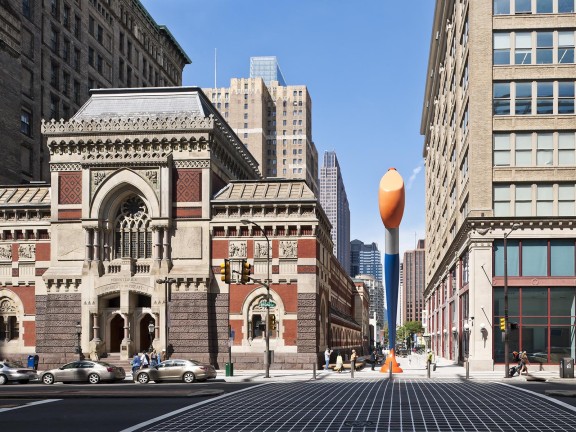Pennsylvania Academy of the Fine Arts

The Pennsylvania Academy of the Fine Arts is both America’s oldest art school and our first art museum. It was established in 1805 by painter and scientist Charles Willson Peale, sculptor William Rush, and other artists and business leaders. First housed in a Greek Revival building in the 1000-block of Chestnut Street (which burned in 1845 and was replaced in the same style), the academy staged a competition in 1871 for the design of a new, larger home on Broad Street, north of the site where City Hall was then rising.
Victory in the competition was one of the first successes of Philadelphia’s greatest Victorian architect, Frank Furness (1839-1912), then working in partnership with George Hewitt. His eye-grabbing design is an eclectic synthesis of Gothic, Greek, and French Renaissance architecture, constructed of a multi-colored palette of stone and brick. Planned with the logic that Furness would bring to the scores of buildings that he created for Philadelphia’s banks, railroads, and other commercial clients, the Academy’s top floor was devoted to airy, skylit galleries, whose iron framing was proudly exposed. The ground floor studios, used by the school, received even light from north-facing clerestory windows.
The new building opened in 1876, in time for the Centennial Exhibition, and in 1882 the reorganized school hired former student Thomas Eakins, who had been working as an instructor, as its director. Meanwhile the museum was expanding its collection. For more than a half century, the academy played a leading role in the American art world. Notable students included Edwin Austin Abbey, both Alexander Milne Calder and his son Alexander Stirling Calder, Mary Cassatt, William Harnett, Robert Henri, Maxfield Parrish, and Henry Ossawa Tanner. Notoriously, Eakins was dismissed in 1886 for his use of nude models, but his example of unblinking observation continued to shape the school.
Like many of the greatest monuments of Victorian architecture, the academy building fell out of favor in the first decades of the twentieth century, and many of its details were covered up. But Furness was among the first Victorian architects to enjoy a revival, and the Pennsylvania Academy was beautifully restored by the architect Hyman Myers in time for its centenary—and the bicentennial of the nation—in 1976.
Photo Credit: The Pennsylvania Academy of Fine Arts
Contact: [email protected]